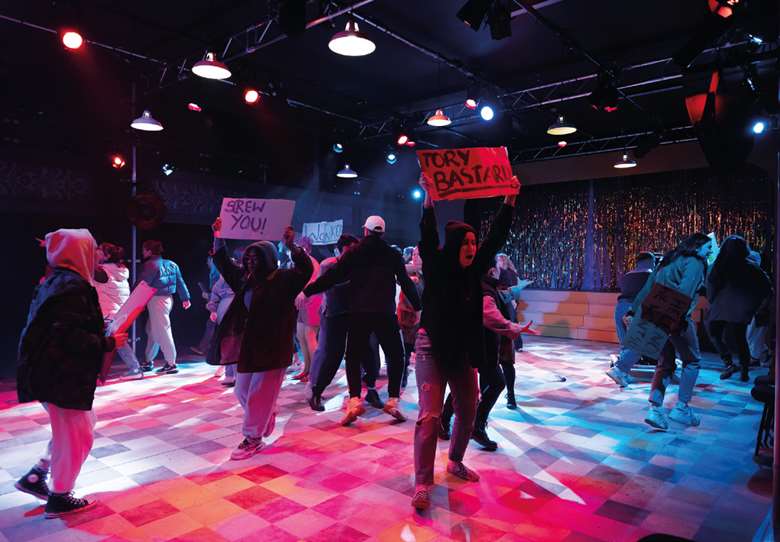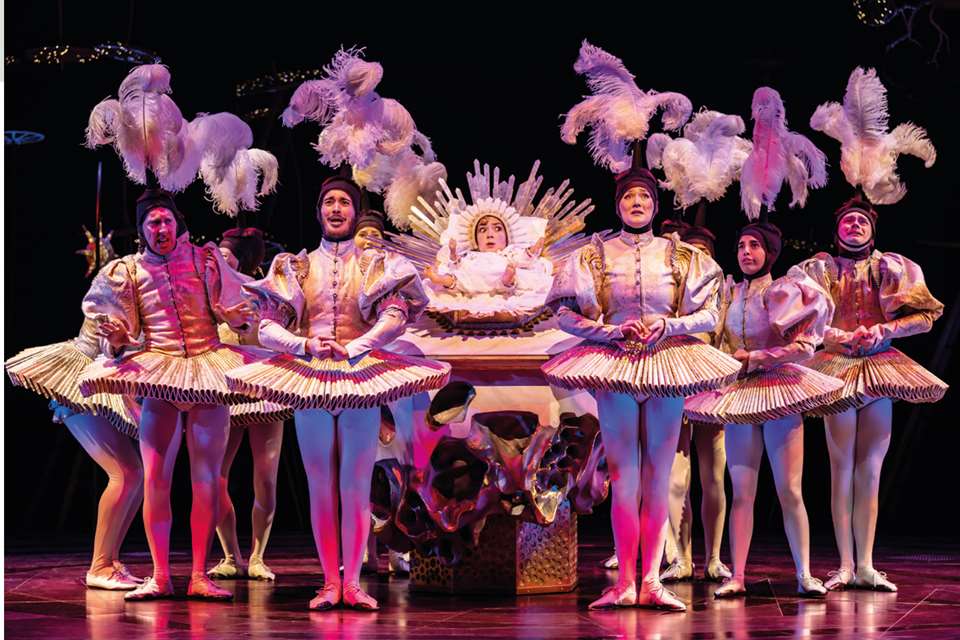Play for performance: The Real Estate
Freddie Machin
Wednesday, March 1, 2023
Each issue of D&T we bring you a page-to-stage focus on a play for performing with your students. This issue, Freddie Machin introduces his play The Real Estate.

Sam Cartwright
On any given year at the largest arts festival in the world you will probably be able to see a play in a caravan, a car, a converted shipping container and a toilet cubicle. Theatre thrives in intimate spaces, which is why so many writers are instructed to write small plays that are stageable in any small room capable of a decent blackout. If you are taking a show to the Edinburgh Fringe then brevity makes practical, artistic and economic sense.
But all this emphasis on the minimal presents a problem for schools and colleges that are looking to populate larger stages, and as a consequence, contemporary plays for large casts are hard to find.
What's the story?
Allow me to introduce The Real Estate. It's a whopper, originally commissioned for a cohort of 32 actors in their final year of drama school training at Italia Conti – but it can hold even more. It's funny, tender, and as well as some meaty central roles, it has a strong theatrical sensibility.
Set on an East London housing estate, it tells the story of a group of residents campaigning to save themselves from eviction when their new corporate landlords threaten to convert their block into luxury accommodation. At the same time, a film crew has descended on the estate to shoot a movie based on the real life events that make up the block's origin story way back in the 1960s.
The play moves between the taut family drama that unfolds amongst the residents, the tensions and egos that are part and parcel of a film crew working against the clock, and scenes from the drama which is being recorded. The conflict between these three distinct worlds forms the central conflict of the play – who does this prime piece of real estate belong to? Who has the right to tell its story? And how far would you go to save your home?
Set the stage
The play offers the opportunity for a number of large set pieces including a protest and a pageant, in which the stage can be flooded with any number of characters. Song and dance are a central part of these two moments, giving companies the chance to showcase choral singing, dance and choreographed movement.
Although the story is set very much within a contemporary, metropolitan aesthetic, it also depicts the estate in the 1960s seen through the lens of a film camera. One enjoyable challenge of mounting the play is working out how to navigate the theatricality of these transitions. Moving from an abandoned community hall to a working film set, and then onto a champagne reception in the 1960s will engage the minds of technical students and stage managers interested in telling the story through lighting and sound, costume and props.
Amie Burns Walker directed a recent production with third year BA students at the Institute for Contemporary Theatre in Brighton. The contemporary issues of gentrification, social cleansing, and profits v people struck a real chord with her company. ‘The students I worked with loved this play and really took ownership of it,’ she says. ‘The play provided the opportunity for loads of research as well as looking at more nuanced family relationships. It depicts important and relevant issues and will light a fire under the actors, encouraging them to make art that is political as well as entertaining.’
Real-life real estate
The play is inspired by a range of real-life examples of residents fighting back against profiteering landlords, such as the New Era Estate in Hoxton, Focus E15 in Newham, Robin Hood Gardens in Poplar. While Erno Goldfinger's brutalist masterpieces (that bookend the London skyline) inform the mythology of the play's fictional housing block, Hawksmoor House.
Justin Joseph directed the play at Latymer Upper School in West London, drawing on students from every year in the secondary school. He noted however that opportunities for lots of actors also throws up certain challenges:
Although the large cast creates opportunities for lots of actors, it can also throw up certain challenges. Justin Joseph directed the play at Latymer Upper School in West London, drawing on students from every year in the secondary school. ‘Although I was looking for a play with a large cast, it is harder to generate commitment from those who are only in a couple of scenes,’ he says. ‘Doubling up and using a smaller ensemble might be the answer.’
He adds, ‘The other challenge is that it is a relatively long play, and although Freddie generously allowed us to cut some parts, I think it needs to move at pace, and requires a particularly strong sense of narrative drive.’ There are of course lots of possible cuts that can be made to the script and plenty of potential for doubling. Keeping the pace high is always good advice, and Justin said the audience response was excellent: ‘I actually found it a very moving play. It's funny, the characters are great, it offers lots of good young roles for younger actors, and the others are big and fun to play. Also, the dialogue has a rhythm that the young actors can use and they find the language accessible.’
The Real Estate is available for performance courtesy of Nick Hern Books. You can download an extract and arrange a licence from multiplaydrama.co.uk.







